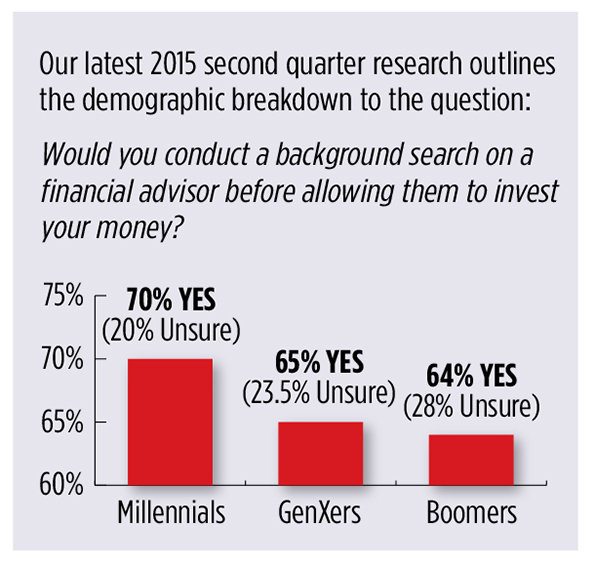When was the last time you Googled yourself? If you haven’t lately, give it a go.
One advisor client recently conducted a Google search. The first result was a report of his arrest in college for marijuana possession. How’s that for branding?
Fortunately, a business coach was able to line this advisor up with an online reputation company to push down the embarrassing Google search results to the second page. About 86 percent of people select one of the top 8 listings. And according to Pew Research, 94 percent of research begins with an online search.
This financial advisor discovered rather quickly, and somewhat painfully, that his branding had gone digital. So has yours.
What Defines A Financial Advisor's Online Brand?
1. Google search results (what Googles says about you).
2. Your LinkedIn and Facebook presence.
3. Your personal website.
4. FINRA’s brokercheck (what’s on your U4).
5. Your interactions on social media (what you say and what others say about you online).
Millennials grew up in a digital world (Gen Xers were early adopters) and word-of-mouth influence has become more pronounced amongst these groups, albeit with a slightly different wrinkle. Yes, they talk about their likes and dislikes with family, friends and colleagues—just like their predecessors—but they communicate more heavily online. About 80 percent of Millennials use social media for word-of-mouth recommendations.
Google has been around for a long time, and it’s matured to where everyone now uses it as the primary research tool. In a terrific book called The Next America, Paul Taylor and the Pew Research Center explain this “Evolution of Technology,” making reference to economist Simon Kuznet and his “The Kuznet Curve”…
- First generation technology usually causes ‘net negative’ social effects (cell phone attached in car).
- Second generation has a ‘net neutral’ social effect (first clunky portable cell phone).
- Third generation—once the technology is smart enough, we’ve got the interface right and it begins to reinforce the best behaviors—we finally get to "net positive" effects (smart phone).
Considering the frequency and ease with which people currently engage in Google searches, the online information search is in the third generation of The Kuznet Curve.
The trend line is moving steadily towards every financial advisor routinely having their background checked by current and future clients.

Your Digital Defense Game Plan
1. Google Yourself. Add variations of “financial advisor” “financial planner,” etc. What comes up? If something inappropriate appears, hire an online reputation company.
2. Your LinkedIn and Facebook Presence. How's your branding? Are you connected with top clients, prospects and COIs? Are you actively listening and posting comments to clients', prospects' and COIs' posts?
3. Your Website. Does it represent you properly?
4. Search Rankings. Where do you appear in a search for “financial advisors (your city here)”?
5. Google Alerts. Set these up to be notified when you’ve been mentioned online.
6. U4. Do you have talking points (length of service, complaints, etc.)?
7. Thought Leadership. Post weekly thought leadership content through social media to spur positive word-of-mouth. (It doesn’t have to be content you create, simply content you curate.)
There's no magic pill that creates the perfect digital brand. Rather, it’s a composite of everything out there in the digital airspace. So, pay attention, be active, become a proactive listener, and put out thought leadership content.
When it comes to branding, you can forget the brochure—your brand is now digital. It’s fluid and more critical than you might realize, so stay on top of it.


